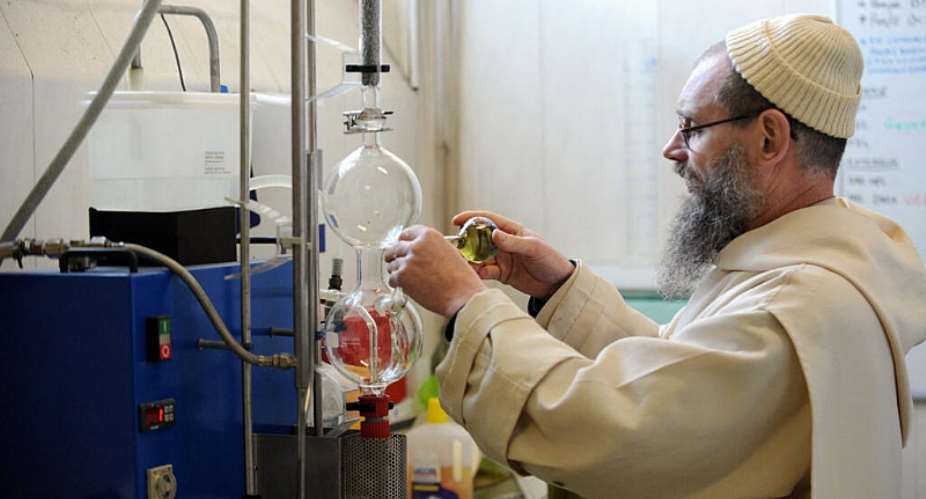Demand from the United States for the plant-based liqueur Chartreuse has never been greater. But the French monastic community that makes it has refused to up production, preferring to save time for contemplation and preserving the planet.
The Grande Chartreuse monastery, in the French Alps near Grenoble, has been making its eponymous liqueur since the early 17th century.
Monks from the Carthusian order follow a recipe so secret that only two of the 30-strong community know it at any one time.
The vibrant green liqueur, or its mellower yellow version, is made from more than 130 alpine plants – and therein lies a problem.
Some of the plants, already rare, are becoming scarcer with climate change.
In January this year, the monks issued a statement saying they would not be increasing production to meet rising demand, which has been driven largely by a US craze for cocktails featuring the bittersweet drink.
"Infinite growth is no longer possible,” the prior of the Grande Chartreuse, Dom Dysmas, recently told the administrators of Chartreuse Diffusion, the company that markets the drink and in which the monks are majority shareholders.
Underpinning the cap in production is the monks' desire to focus on their "primary goal" of solitude and prayer, they explained.
They also want to limit their business's environmental footprint, bumped up its international shipping.
In 2022, sales worldwide exceeded $30 million, according to Chartreuse Diffusion. Of the 1.6 million bottles produced produced annually, half go to the US.
The aim is "to ship all our bottles to the New York market by sailboat by 2024-2025", CEO Emmanuel Delafon told French newspaper Dauphiné Libéré.
"Solutions exist – yes, they cost more, but yes, we must pay that price tomorrow,” he said.
Cocktail craze
The recent US craze for Chartreuse reportedly began in 2003, when a bartender in Seattle popularised a cocktail known as The Last Word – a mix of gin, Chartreuse, maraschino liqueur and lime juice.
But the drink has a much older history, rooted in the Prohibition era.
“The Last Word was created in a club in downtown Detroit called The Detroit Athletic Club in – I believe – 1915 or '16,” says Joe Kakos, one of the owners of the family-run Kakos Market liquor store in neighbouring Birmingham, Michigan.
During the Covid pandemic, when people began making cocktails at home, "they were looking for these classic old-world cocktails", he says.
According to Kakos, Chartreuse h ad "the history and the mystery" that made it particularly attractive.
Learning to savour
Since the monks dropped their bombshell, Chartreuse has become even more sought after, and yet sellers like Kakos receive only limited supplies.
"We are allocated three bottles of green and/or yellow every few months, that's all I get now," he tells RFI. "I have to turn lots of clients away."
Despite the frustration of not being able to satisfy his clients, Kakos says he "fully supports the monks".
He even sees a plus side to the scarcity.
In contrast to the "Amazon age where everyone expects things at the drop of a hat", he says, people are learning to "measure the amounts and enjoy every bit of it".
A different spirit
The monks, meanwhile, are diversifying their activities, returning to their Medieval roots as fine connaisseurs of herbal medecine.
They've already begun working with three other Carthusian orders to grow, dry and commercialise herbal teas.
"We've turned into farmers over the last year, with pilot projects in three monasteries in the Var, Ain and Aveyron regions," said Delafon. "The recipes are based on what the monks will be able to cultivate on their lands."
The monks are moving with the times – which more and more means focusing on the circular, rather than global, economy.
Read also:





 I don’t need your money before I can make fair judgment; the Golden Stool takes ...
I don’t need your money before I can make fair judgment; the Golden Stool takes ...
 ‘EC has become a clear and present danger in Ghana’s democracy’ — Kofi Bentil
‘EC has become a clear and present danger in Ghana’s democracy’ — Kofi Bentil
 Election 2024: NPP has spent millions trying to rebrand Bawumia but it has faile...
Election 2024: NPP has spent millions trying to rebrand Bawumia but it has faile...
 ‘Your comments on ‘dumsor’ causing even more disaffection for Bawumia’ — Prof Gy...
‘Your comments on ‘dumsor’ causing even more disaffection for Bawumia’ — Prof Gy...
 Mahama and his brother Ibrahim are traitors, support NPP in disguise to collapse...
Mahama and his brother Ibrahim are traitors, support NPP in disguise to collapse...
 Covid-19 levy: Even ‘wicked Nebuchadnezzar’ won’t do this — Sammy Gyamfi slams A...
Covid-19 levy: Even ‘wicked Nebuchadnezzar’ won’t do this — Sammy Gyamfi slams A...
 US court jails Ghanaian couple 25 years to life for beating their son to death
US court jails Ghanaian couple 25 years to life for beating their son to death
 Bawumia is experienced in heaping useless, senseless taxes on Ghanaians — Sammy ...
Bawumia is experienced in heaping useless, senseless taxes on Ghanaians — Sammy ...
 ’Investigate EC for misappropriating, wasting Ghana’s scarce resources — IMANI A...
’Investigate EC for misappropriating, wasting Ghana’s scarce resources — IMANI A...
 Kasoa shooting: 'Some police officers are in bed with criminals' — Charles Owusu
Kasoa shooting: 'Some police officers are in bed with criminals' — Charles Owusu
